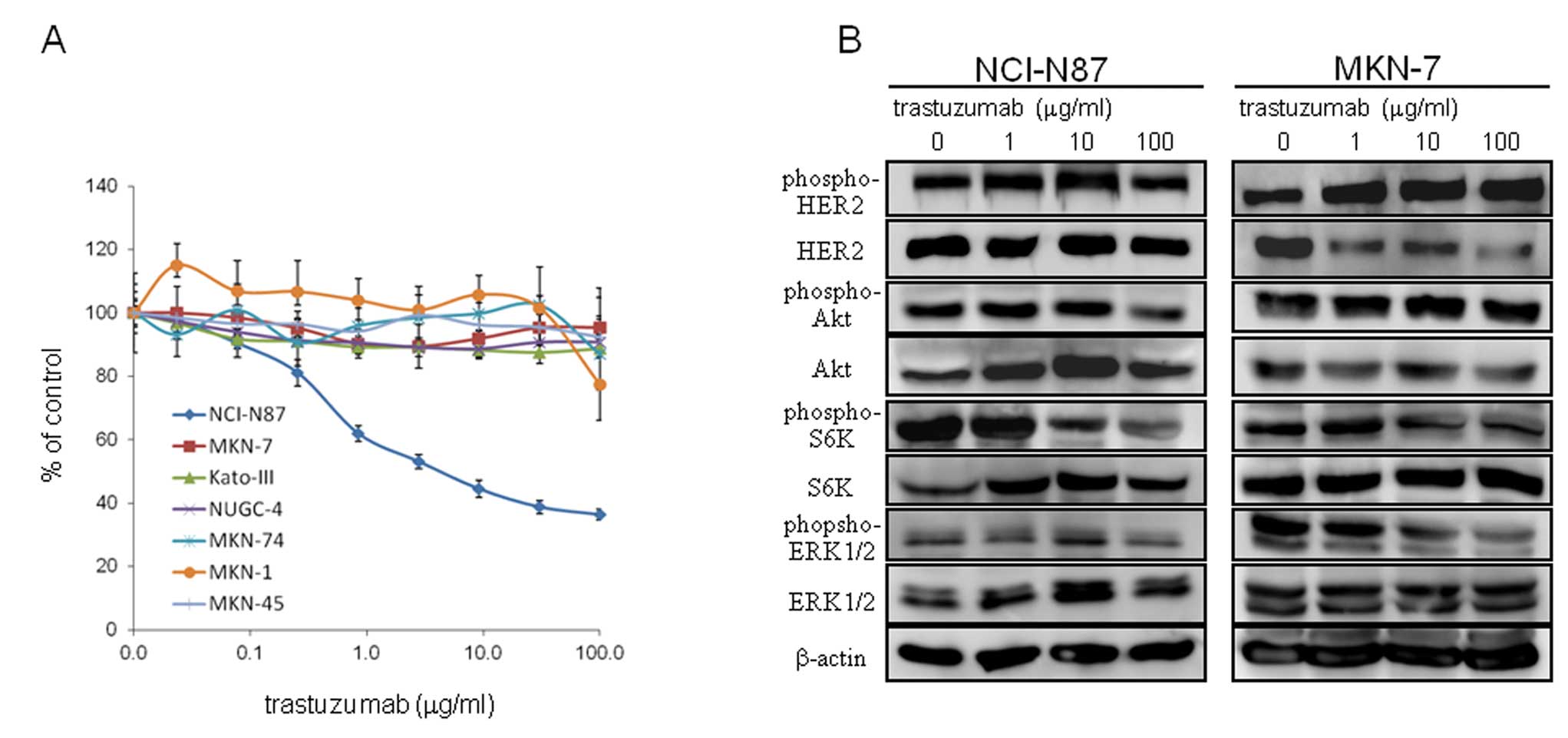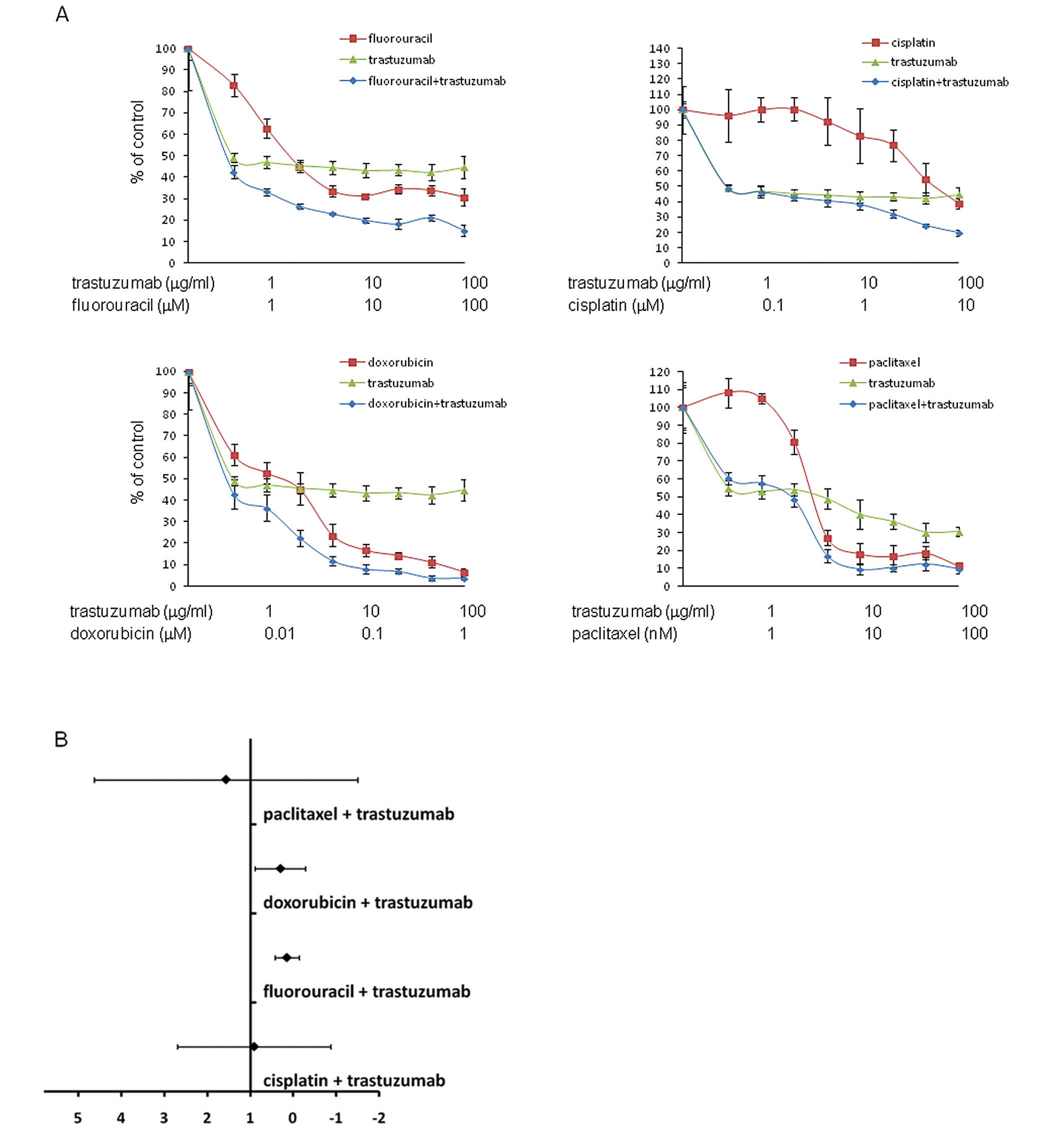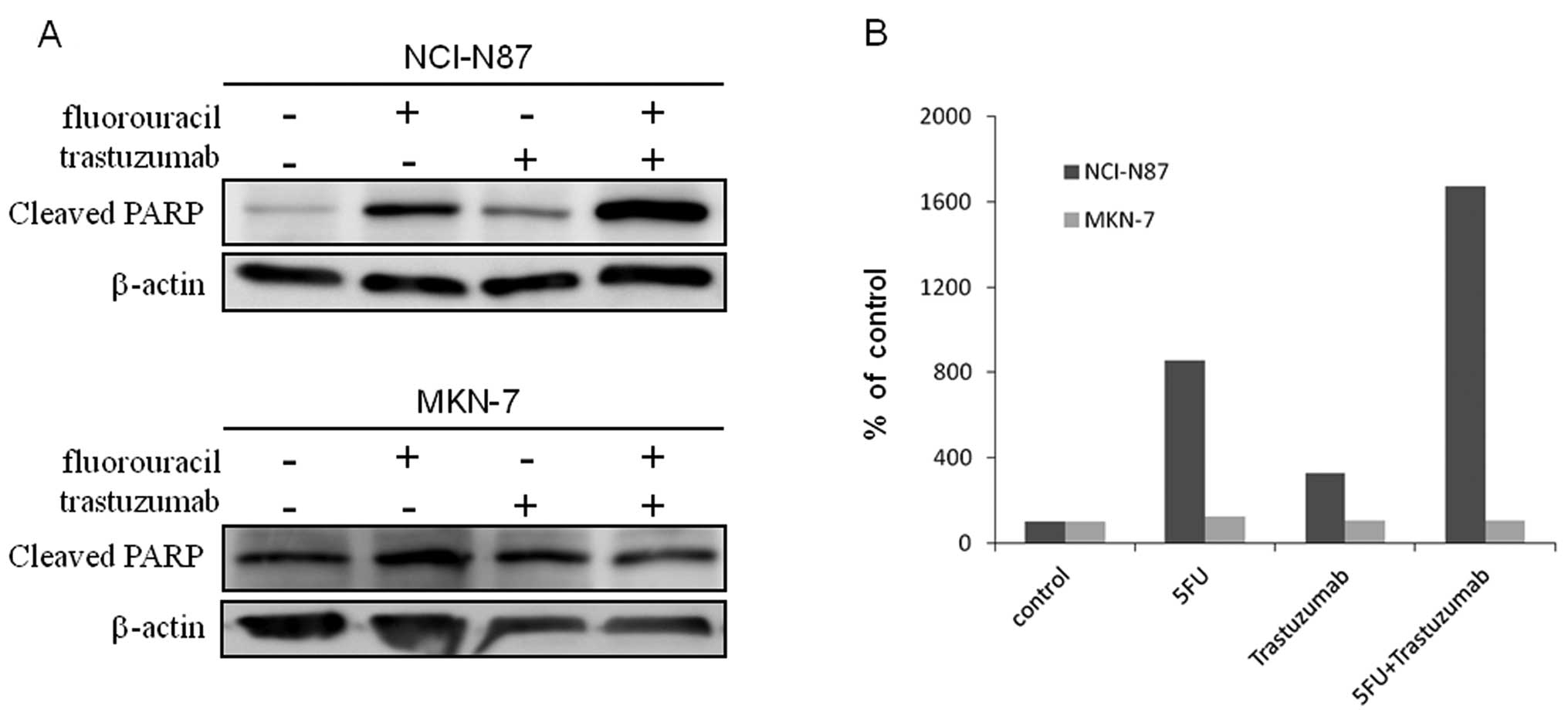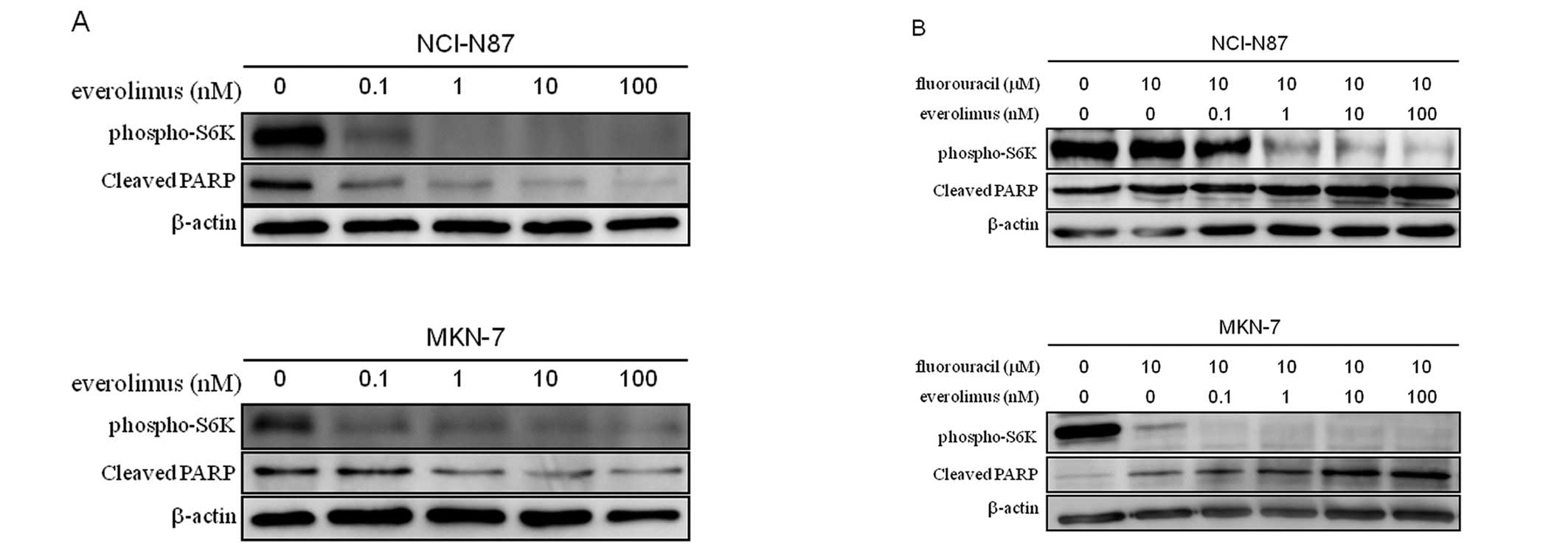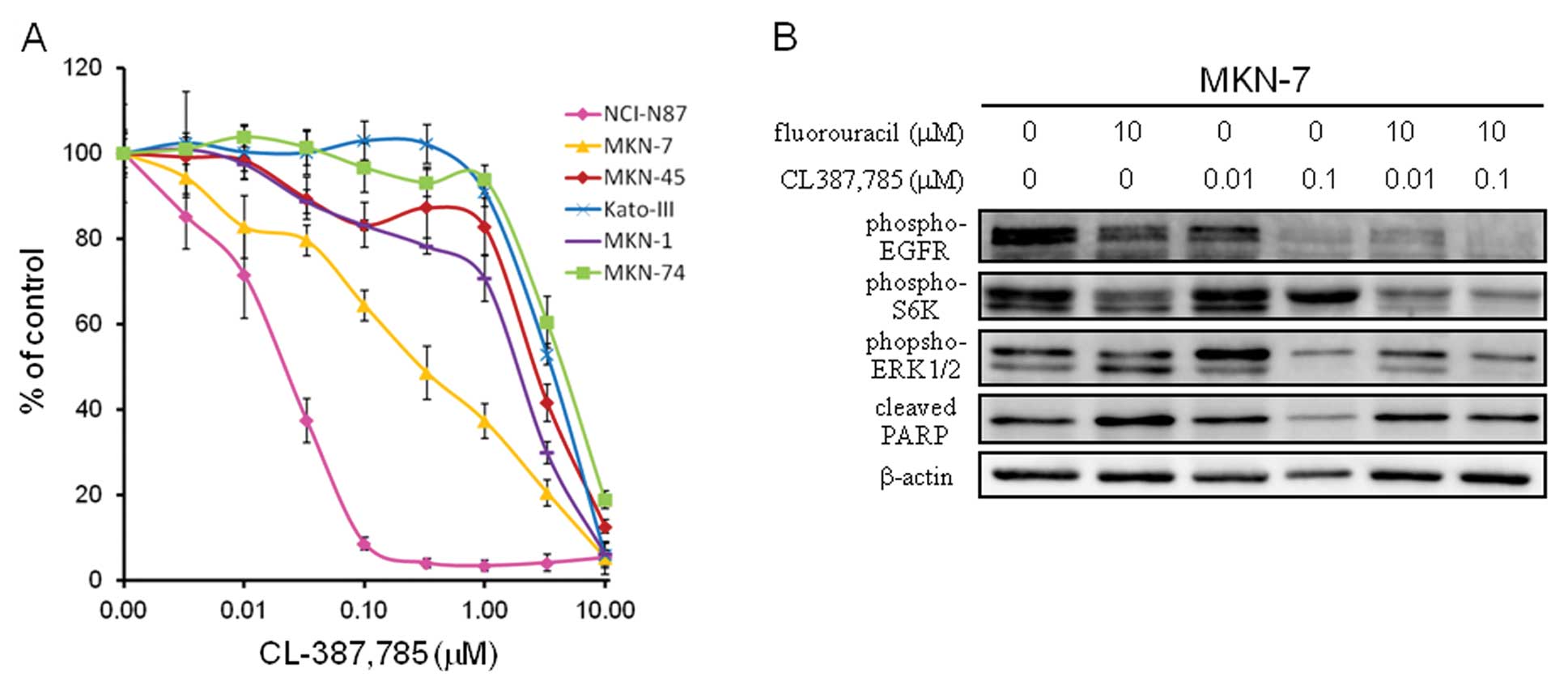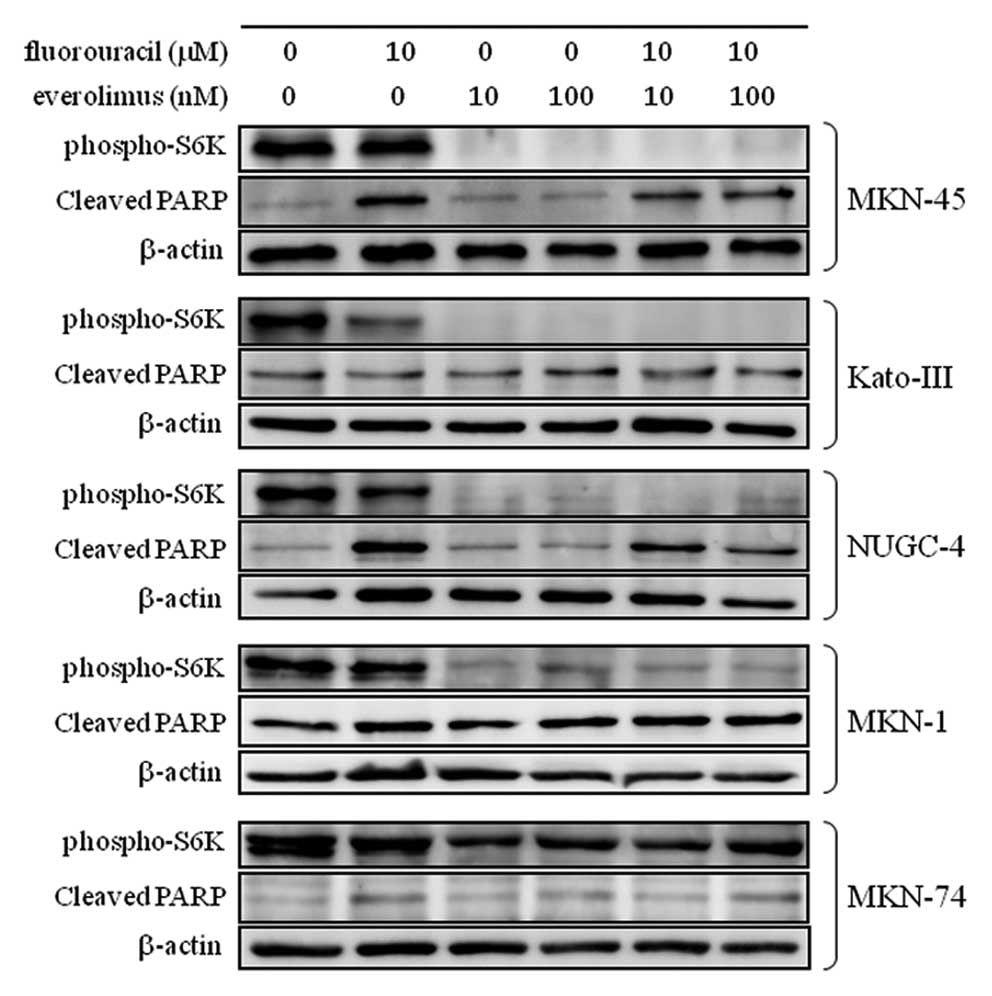Inhibition of the mTOR/S6K signal is necessary to enhance fluorouracil-induced apoptosis in gastric cancer cells with HER2 amplification
- Authors:
- Published online on: May 17, 2012 https://doi.org/10.3892/ijo.2012.1485
- Pages: 551-558
Abstract
Introduction
Gastric cancer is the fourth-most common cancer and the second leading cause of cancer death worldwide (1,2). When diagnosed in its early stages, a surgical approach with a partial or total gastric resection are often successful (3). However, when diagnosed with primarily unresectable disease or recurrence after surgery (4), the disease is no longer curable despite systemic chemotherapy with cytotoxic chemotherapeutic agents, including fluorouracil, cisplatin, doxorubicin and paclitaxel, either alone or in combination. Response rates to these chemotherapies are generally less than 50% and median survival time from diagnosis is less than one year (5). New treatment strategies are therefore urgently required.
Molecularly targeted agents, particularly those targeting receptor tyrosine kinases (RTKs), have been successfully used in clinical settings since the late 1990s. The most promising of these have generally been those targeting RTKs with genetic changes causing aberrant activation. These include trastuzumab, a monoclonal antibody against extracellular domain of human epidermal growth factor receptor 2 (HER2), in HER2-overexpressing breast cancer (6); and erlotinib and gefitinib, which inhibit epidermal growth factor receptor (EGFR) with somatic mutations in non-small cell lung cancer (7,8). In gastric cancer, gene amplification in HER2, MET, and fibroblast growth factor receptor 2 (FGFR2) have been reported in 20%, 20%, and 40% of tumor samples, respectively. While HER2 amplification is predominantly found in the well-differentiated intestinal subtype (9–14), MET and FGFR2 amplification occur more frequently in the undifferentiated diffuse subtype (15). The potential of these RTKs as therapeutic targets in gastric cancer was clinically demonstrated by the success of the ToGA (Trastuzumab for Gastric Cancer) study, at least in part (16). This open-label, international, phase III randomized controlled trial compared cisplatin plus fluorouracil or capecitabine (reference arm) versus the same regimens combined with trastuzumab in HER2-overexpressing advanced gastric cancer. Results showed that the trastuzumab-containing arm was superior to chemotherapy alone with regard to response rate, progression-free survival, and overall survival (16).
Although the ToGA trial shed light on the strategy of targeting gene-amplified RTK in gastric cancer, several questions remained to be answered, including whether trastuzumab enhances the effect of chemotherapeutic agents even in trastuzumab-resistant HER2-amplified gastric cancer cells, and the control of trastuzumab-resistant HER2-amplified cells.
Here, we compared the effects of trastuzumab in two HER2-amplified gastric cancer cell lines in vitro, one of which has been reported to be sensitive to anti-HER2 monoclonal antibody (NCI-N87) and the second to be insensitive (MKN-7).
Materials and methods
Cell culture
NCI-N87 cells were purchased from American Type Culture Collection (ATCC, Manassas, VA, USA). NUGC-4, MKN-7, KATO-III, MKN-45, MKN-1, and MKN-74 cells were purchased from RIKEN BioResource Center (Tsukuba, Japan). Both NCI-N87 and MKN-7 cells have been reported to have amplification of the HER2 gene (17,18). NCI-N87 cells were reported to be sensitive to trastuzumab in vitro (19), while MKN-7 cells were shown to be resistant to monoclonal antibody 4D5, which has the same antigen-binding fragment (Fab) as trastuzumab (20).
All cell lines were maintained in RPMI-1640 (Cellgro) supplemented with 10% fetal bovine serum (FBS), 100 U/ml penicillin, 100 U/ml streptomycin, and 2 mM glutamine. All cells were grown at 37°C in a humidified atmosphere with 5% CO2 and were in the logarithmic growth phase upon initiation of the experiments. The cells were passaged for ≤3 months before fresh cells were obtained from frozen early-passage stocks received from the indicated sources.
Drugs
Evelorimus (RAD001), an inhibitor of mTOR, was kindly provided by Novartis Pharma (Basel, Switzerland). Fluorouracil, cisplatin, doxorubicin and paclitaxel were purchased from Wako (Osaka, Japan). Trastuzumab was obtained from the Kobe University Hospital Pharmacy. CL-387,785, an inhibitor of EGFR/HER2, was purchased from Calbiochem (San Diego, CA, USA). Stock solutions were prepared in dimethyl sulfoxide (DMSO) and stored at −20°C. The drugs were diluted in fresh media before each experiment, with final DMSO concentrations less than 0.1%.
Antibodies and western blotting
Cells were washed with ice-cold PBS and scraped immediately after the addition of lysis buffer [20 mM Tris (pH 7.5), 150 mM NaCl, 10% glycerol, 1% NP40, and 2 mM EDTA] containing protease and phosphatase inhibitors [100 mM NaF, 1 mM phenylmethylsulfonyl fluoride (PMSF), 1 mM Na3VO4, 2 μg/ml aprotinin, and 5 μg/ml leupeptin). Lysates were centrifuged at 14,000 relative centrifugal force for 10 min. Supernatants were collected as protein extracts and then separated by electrophoresis on 7.6% sodium dodecyl sulfate (SDS)-polyacrylamide gels, followed by transfer to nitrocellulose membranes (Millipore, Billerica, MA, USA) and detection by immunoblotting using the enhanced chemiluminescence system (New England Nuclear Life Science Products, Boston, MA, USA). HER2/ErbB2 (44E7), phospho-HER2/ErbB2 (Tyr1221/1222)(6B12), Akt, phospho-Akt (Ser473)(D9E), p70 S6 kinase, phospho-p70 S6 kinase (Thr389), and cleaved-PARP (Asp214)(D64E10) antibodies were purchased from Cell Signaling Technology (Beverly, MA, USA). Phospho-EGFR (Y1068), ERK1/2, phospho-ERK1/2 (pT185/pY187) antibodies were purchased from Invitrogen (Carlsbad, CA, USA), and β-actin antibody was purchased from Sigma-Aldrich (St. Louis, MO, USA). Immunoblot quantification was carried out by densitometry using ImageJ software (21).
Cell growth assay
Growth inhibition was assessed using the MTS assay (Promega, WI, USA), a colorimetric method for determining the number of viable cells based on the bioreduction of 3-(4,5-dimethylthiazol-2-yl)-5-(3-carboxymethoxyphenyl)-2-(4-sulfophenyl)-2H-tetrazolium (MTS) to a soluble forma-an product, which is detectable by spectrophotometry at a wavelength of 490 nm. Cells were diluted in 160 μl/well of maintenance cell culture media and plated in 96-well flat-bottom plates (Corning, Lowell, MA, USA). After a 144-h growth period, the number of cells required to obtain an optical density (OD) within the linear range of the assay, 1.3–2.2, was determined for each cell line with pilot experiments. The number of cells per well used in the subsequent experiments was as follows: NCI-N87: 5,000; MKN-7: 3,000; KATO-III: 3,000; MKN-1: 2,000; MKN-45: 1,500; MKN-74: 2,000 and NUGC-4: 2,000. At 24 h after plating, cell culture media were replaced with 10% FBS containing media with and without drugs followed by incubation for an additional 120 h. A total of 6 to 12 replicate wells were established for each experimental point and all experiments were performed at least in triplicate. Data are expressed as a percentage of growth relative to that of untreated control cells.
Combination index (CI)
Interaction between trastuzumab and cytotoxic chemotherapeutic agents was evaluated by the median-effect method (CalcuSyn software; Biosoft) to determine the well-established CI (22), with which CI values ≤1, and >1 indicate synergistic, additive, and antagonistic effects, respectively (23). The maximum concentration of trastuzumab was set at 100 μg/ml, on the basis that this concentration is close to the maximum plasma concentration of trastuzumab observed clinically, and has been widely used in previous studies (24). Maximum concentrations of fluorouracil, doxorubicin, cisplatin, and paclitaxel was set at 100 μM, 1 μM, 10 μM, and 100 nM, respectively, based on their approximate IC90 values as determined by pilot experiments using the NCI-N87 cell line (data not shown). Serial two-fold dilution with a fixed concentration ratio of chemotherapeutic drug/trastuzumab was done, and total CI was represented as the average of CI at each experimental point.
Results
Effect of trastuzumab on cell growth in gastric cancer cell lines
We first screened seven gastric cancer cell lines for in vitro growth inhibition by trastuzumab (Fig. 1A). Results confirmed that trastuzumab was not effective in five non-HER2-amplified gastric cancer cell lines (IC50 >100 μg/ml). Of the two HER2-amplified cell lines, only NCI-N87, and not MKN-7, was more sensitive than non-HER2-amplified cells, consistent with previous studies (19,20).
Effect of trastuzumab on cell signaling in NCI-N87 and MKN-7 cell lines
To explore the underlying mechanism of the differential effect of trastuzumab in NCI-N87 and MKN-7, we examined phosphorylation of HER2 and representative downstream signaling molecules in 10% FBS-containing media with and without increasing the concentration of trastuzumab. The most remarkable difference in signaling outcome after trastuzumab treatment was a decrease in phosphorylation of S6K, which was observed only in NCI-N87, and not in MKN-7 (Fig. 1B).
Synergistic effect of trastuzumab and cytotoxic drugs in NCI-N87 cell line
We next investigated synergy between trastuzumab and the clinically relevant cytotoxic drugs fluorouracil, cisplatin, doxorubicin and paclitaxcel in HER2-amplified NCI-N87 and MKN-7. In trastuzumab-sensitive NCI-N87, the combination of trastuzumab and fluorouracil or doxorubicin resulted in a CI value of 0.14 [95% confidence interval (CI)-0.11–0.39] and 0.30 (95% CI,-0.15–0.75), respectively, indicating significant synergy between the drugs (Fig. 2A and B). In trastuzumab-insensitive MKN-7, in contrast, trastuzumab and the individual chemotherapeutic drugs resulted in a 95% confidence interval for the CI value crossing 1, which indicates no significant synergy between the drugs (Fig. 2C and D).
Fluorouracil-induced apoptosis in HER2-amplified gastric cancer cells
Because the combination of trastuzumab and fluorouracil showed the most promising synergy in the NCI-N87 cell line (Fig. 2A and B), we decided to explore the mechanism of the synergistic effect of the drugs in subsequent experiments.
To evaluate the level of apoptosis, we used western blot analysis for cleaved poly (ADP-ribose) polymerase (PARP), which is indicative for apoptosis. In the NCI-N87 cell line, while trastuzumab by itself produced a slight increase in cleaved PARP compared to control, the combination of trastuzumab and fluorouracil resulted in even higher level of cleaved PARP compared to either drug alone (Fig. 3A and B). In MKN-7, in contrast, trastuzumab alone did not produce an increase in cleaved PARP compared to control, while the combination of trastuzumab and fluorouracil did not increase cleaved PARP expression compared to either drug alone (Fig. 3A and B). These results indicated that the synergy observed in NCI-N87 cells treated with trastuzumab and fluorouracil (Fig. 2A and B) was likely attributable to the enhancement of fluorouracil-induced apoptosis by trastuzumab. They also indicate that the synergistic effect of trastuzumab and fluorouracil may be limited to cell lines sensitive to trastuzumab itself.
Effect of everolimus in NCI-N87 and MKN-7 cell lines
Because a decrease in the phosphorylation of S6K on treatment with trastuzumab was observed only in NCI-N87, and not in MKN-7 (Fig. 1B), we hypothesized that inhibition of the phosphorylation of S6K may be an important molecular event for trastuzumab in its enhancement of fluorouracil-induced apoptosis and synergistic effect with the drug. Therefore, we next evaluated the effect of the mTOR inhibitor everolimus on cell signaling and fluorouracil-induced apoptosis in the two HER2-amplified gastric cell lines. As seen in Fig. 4A, while everolimus alone inhibited phosphorylation of S6K, it instead decreased the expression of cleaved PARP as compared to control in both cell lines. When combined with fluorouracil, however, everolimus inhibited phosphorylation of S6K and appeared to enhance fluorouracil-induced apoptosis in a dose-dependent manner in both cell lines (Fig. 4B). These results strengthen the notion that inhibition of the phosphorylation of S6K be a key molecular event in enhancing fluorouracil-induced apoptosis.
Effect of fluorouracil in combination with CL-387,785 in MKN-7
MKN-7 was previously shown to be resistant to anti-HER2 monoclonal antibody 4D5 because of alternative signaling from overexpressing EGFR (17). Therefore, we next evaluated the effect of CL-387,785, an EGFR/HER2 inhibitor, on cell growth, cell signaling and fluorouracil-induced apoptosis in MKN-7.
As seen in Fig. 5A, treatment of MKN-7 with CL-387,785 resulted in growth inhibition, albeit to a lesser extent than in NCI-N87. In the western blot analysis, treatment of CL-387,785 resulted in decrease in phosphorylation of ERK1/2 versus only a mild decrease in that of S6K (Fig. 5B). Consistent with this, the addition of CL-387,785 to fluorouracil did not increase the expression of cleaved PARP compared to fluorouracil alone (Fig. 5B). This finding again supports the notion that inhibition of the mTOR-S6K signal may be important in enhancing fluorouracil-induced apoptosis. Further, it suggests that growth inhibitory effect of anti-RTK agent alone does not guarantee its ability to enhance chemotherapy-induced apoptosis.
Synergistic effect of everolimus in combination with fluorouracil in the second gastric cancer cell line
To evaluate whether the mTOR-S6K signal in fluorouracil-induced apoptosis is universally important in all gastric cancers, we next tested other gastric cancer cell lines for fluorouracil-induced apoptosis. MKN-45, KATO-III, NUGC-4, MKN-1 and MKN-74, which have been reported to harbor MET-amplification (25), FGFR2-amplification (25), EGFR-mutation (E746-A750 del), PIK3CA-mutation (E545K) (26), and B-RAF mutation (G466V), respectively (27), were treated with everolimus, fluorouracil, or their combination. Phosphorylation of S6K and cleavage of PARP were analyzed as shown in Fig. 6. Everolimus dramatically decreased the phosphorylation of S6K in all cell lines except MKN-74, while the combination of fluorouracil and everolimus did not increase cleaved PARP expression compared to fluorouracil alone in any of the cell lines. This finding suggests that the mTOR-S6K signal in fluorouracil-induced apoptosis is not universal, but somewhat specific to HER2-amplified gastric cancer cell lines.
Discussion
In this study, we found that while trastuzumab administered together with fluorouracil or doxorubicin synergistically enhanced apoptosis in the trastuzumab-sensitive HER2-amplified gastric cancer cell line NCI-N87, no such effect was seen in trastuzumab-insensitive HER2-amplified MKN-7 cells. We also found that inhibition of the phosphorylation of S6K appeared to be a key molecular event in the enhancement of fluorouracil-induced apoptosis, indicating that the mTOR inhibitor everolimus might be an attractive back-up drug for HER2-amplified gastric cancers.
Several previous studies evaluated the ability of trastuzumab to produce synergy with chemotherapeutic agents in HER2-amplified gastric cancer cell lines. Kim et al (28) reported a synergistic effect between trastuzumab and cisplatin but only an additive effect between trastuzumab and fluorouracil or oxaliplatin using the SNU-216 cell line. Tanizaki et al (29) reported synergy between trastuzumab and fluorouracil in three HER2-amplified gastric cancer cell lines, NCI-N87, MKN-7, and SNU-216. These inconsistent results among the studies, including our present study, may be due to differences in experimental conditions. Moreover, none of the previous studies reported the drug concentrations used to test synergy between trastuzumab and chemotherapeutic agents.
In our study, we found that inhibition of the phosphorylation of S6K with treatment with trastuzumab occurred only in NCI-N87 cells, and not in MKN-7 cells. With regard to the phosphorylation of Akt, in contrast, trastuzumab induced no or only modest changes in both cell lines (Fig. 1B). This finding is consistent with our previous study using HER2-amplified breast cancer cell lines, in which the degree of growth inhibition by trastuzumab was more closely correlated with inhibition of the phosphorylation of S6K than of Akt (30). These findings raise the possibility that phosphorylation of S6K might be a pharmacodynamic marker for anti-HER2 therapy in HER2-amplified cancer cells regardless of their origin.
We also found that a decrease in phosphorylation of S6K was necessary to enhance fluorouracil-induced apoptosis in HER2-amplified gastric cancer cell lines. While the mTOR-S6K signal has been characterized as involved in G1/S cell cycle progression by initiating protein translation, this signal is also known to promote cell survival. This latter effect was reported to occur via active S6K phosphorylation of the pro-apoptotic factor BAD at Ser136 (31). The primary role of S6K might differ depending on cell type. As we did not find that everolimus enhanced fluorouracil-induced apoptosis in gastric cancer cell lines which have genetic alteration in RTKs or signaling molecules other than HER2 (Fig. 6), a predominant role of S6K in cell survival might be characteristic in HER2-amplified gastric cancer cells. In some cell lines, the addition of everolimus rather decreased the level of fluorouracil-induced apoptosis compared to fluorouracil alone (Fig. 6). This might be due to the known effect of everolimus to induce cell cycle arrest, under which fluorouracil would not work effectively. Determining the predominant role of S6K in cell cycle progression vs. cell survival in specific cells might therefore be therapeutically important.
The clinical usefulness of everolimus is currently under investigation. A phase II clinical trial of everolimus monotherapy in patients with advanced gastric cancer showed a disease control rate of 56% despite no objective tumor response (32). Further, a randomized, double-blind, multi-center phase III study comparing everolimus plus best supportive care (BSC) with placebo plus BSC in patients with advanced gastric cancer after progression on 1 or 2 prior systemic chemotherapies is now ongoing (33). The results of this trial, particularly the subset analysis based on HER2 status, should provide deeper insight into the importance of the mTOR-S6K signal in the survival of HER2-amplified gastric cancers. Although the combination of capecitabine and everolimus showed only a modest effect in a phase I study (34), evaluating the trastuzumab-fluorouracil (or its derivative) combination after enrichment of the study population with patients whose tumors have HER2-amplification may be worthwhile.
Several limitations of this study warrant mention. First, our use of only two HER2-amplified gastric cancer cell lines precludes the generalization of the results. Compared to breast cancer, substantially fewer HER2-amplified gastric cancer cell lines are available. Confirmation of our findings in other or newly established HER2-amplified gastric cancer cell lines would be valuable.
Second, in addition to its inhibition of HER2 signaling, several studies have indicated the contribution of antigen-dependent cellular cytotoxicity (ADCC) in the antitumor effect of trastuzumab in breast cancer. Because ADCC only works in in vivo conditions, our present data do not necessarily deny the potential effect of trastuzumab on tumors showing resistance to trastuzumab in vitro.
In summary, our findings suggest that inhibition of the mTOR-S6K signal is a key molecular event in enhancing fluorouracil-induced apoptosis in HER2-amplified gastric cancer cells, regardless of sensitivity to trastuzumab. mTOR inhibitors such as everolimus might be attractive back-up drugs in a particular subset of gastric cancers. A better understanding of these findings, however, may require further investigation in clinical trials and associated translational studies.
Acknowledgements
This study was supported by the Global Centers of Excellence Program (H.M.) and Grant-in-Aid for Young Scientists (B) from the Ministry of Education, Culture, Sports, Science and Technology of Japan (T.M), and AstraZeneca Research Grant (T.M).
References
|
Jemal A, Bray F, Center MM, Ferlay J, Ward E and Forman D: Global cancer statistics. CA Cancer J Clin. 61:69–90. 2011. View Article : Google Scholar | |
|
Kamangar F, Dores GM and Anderson WF: Patterns of cancer incidence, mortality, and prevalence across five continents: defining priorities to reduce cancer disparities in different geographic regions of the world. J Clin Oncol. 24:2137–2150. 2006. View Article : Google Scholar | |
|
Sue-Ling HM, Johnston D, Martin IG, et al: Gastric cancer: a curable disease in Britain. BMJ. 307:591–596. 1993. View Article : Google Scholar : PubMed/NCBI | |
|
Menges M and Hoehler T: Current strategies in systemic treatment of gastric cancer and cancer of the gastroesophageal junction. J Cancer Res Clin Oncol. 135:29–38. 2009. View Article : Google Scholar : PubMed/NCBI | |
|
Ajani JA: Evolving chemotherapy for advanced gastric cancer. Oncologist. 10(Suppl 3): 49–58. 2005. View Article : Google Scholar : PubMed/NCBI | |
|
Slamon DJ, Leyland-Jones B, Shak S, et al: Use of chemotherapy plus a monoclonal antibody against HER2 for metastatic breast cancer that overexpresses HER2. N Engl J Med. 344:783–792. 2001. View Article : Google Scholar : PubMed/NCBI | |
|
Paez JG, Janne PA, Lee JC, et al: EGFR mutations in lung cancer: correlation with clinical response to gefitinib therapy. Science. 304:1497–1500. 2004. View Article : Google Scholar : PubMed/NCBI | |
|
Lynch TJ, Bell DW, Sordella R, et al: Activating mutations in the epidermal growth factor receptor underlying responsiveness of non-small-cell lung cancer to gefitinib. N Engl J Med. 350:2129–2139. 2004. View Article : Google Scholar : PubMed/NCBI | |
|
Yokota J, Yamamoto T, Miyajima N, et al: Genetic alterations of the c-erbB-2 oncogene occur frequently in tubular adenocarcinoma of the stomach and are often accompanied by amplification of the v-erbA homologue. Oncogene. 2:283–287. 1988.PubMed/NCBI | |
|
Hofmann M, Stoss O, Shi D, et al: Assessment of a HER2 scoring system for gastric cancer: results from a validation study. Histopathology. 52:797–805. 2008. View Article : Google Scholar : PubMed/NCBI | |
|
Tanner M, Hollmen M, Junttila TT, et al: Amplification of HER-2 in gastric carcinoma: association with Topoisomerase IIα gene amplification, intestinal type, poor prognosis and sensitivity to trastuzumab. Ann Oncol. 16:273–278. 2005.PubMed/NCBI | |
|
Kuniyasu H, Yasui W, Kitadai Y, Yokozaki H, Ito H and Tahara E: Frequent amplification of the c-met gene in scirrhous type stomach cancer. Biochem Biophys Res Commun. 189:227–232. 1992. View Article : Google Scholar : PubMed/NCBI | |
|
Hattori Y, Itoh H, Uchino S, et al: Immunohistochemical detection of K-sam protein in stomach cancer. Clin Cancer Res. 2:1373–1381. 1996.PubMed/NCBI | |
|
Ueda T, Sasaki H, Kuwahara Y, et al: Deletion of the carboxyl-terminal exons of K-sam/FGFR2 by short homology-mediated recombination, generating preferential expression of specific messenger RNAs. Cancer Res. 59:6080–6086. 1999. | |
|
Tsujimoto H, Sugihara H, Hagiwara A and Hattori T: Amplification of growth factor receptor genes and DNA ploidy pattern in the progression of gastric cancer. Virchows Arch. 431:383–389. 1997. View Article : Google Scholar : PubMed/NCBI | |
|
Bang YJ, Van Cutsem E, Feyereislova A, et al: Trastuzumab in combination with chemotherapy versus chemotherapy alone for treatment of HER2-positive advanced gastric or gastro-oesophageal junction cancer (ToGA): a phase 3, open-label, randomised controlled trial. Lancet. 376:687–697. 2010. View Article : Google Scholar | |
|
Neve RM, Lane HA and Hynes NE: The role of overexpressed HER2 in transformation. Ann Oncol. 12(Suppl 1): 9–13. 2001. View Article : Google Scholar | |
|
Yokoyama H, Ikehara Y, Kodera Y, et al: Molecular basis for sensitivity and acquired resistance to gefitinib in HER2-overexpressing human gastric cancer cell lines derived from liver metastasis. Br J Cancer. 95:1504–1513. 2006. View Article : Google Scholar | |
|
Matsui Y, Inomata M, Tojigamori M, Sonoda K, Shiraishi N and Kitano S: Suppression of tumor growth in human gastric cancer with HER2 overexpression by an anti-HER2 antibody in a murine model. Int J Oncol. 27:681–685. 2005.PubMed/NCBI | |
|
Lane HA, Beuvink I, Motoyama AB, Daly JM, Neve RM and Hynes NE: ErbB2 potentiates breast tumor proliferation through modulation of p27(Kip1)-Cdk2 complex formation: receptor overexpression does not determine growth dependency. Mol Cell Biol. 20:3210–3223. 2000. View Article : Google Scholar | |
|
Abramoff MD, Magalhaes PJ and Ram SJ: Image processing with ImageJ. Biophotonics Int. 11:36–42. 2004. | |
|
Pegram MD, Konecny GE, O’Callaghan C, Beryt M, Pietras R and Slamon DJ: Rational combinations of trastuzumab with chemotherapeutic drugs used in the treatment of breast cancer. J Natl Cancer Inst. 96:739–749. 2004. View Article : Google Scholar : PubMed/NCBI | |
|
Chou TC and Talalay P: Quantitative analysis of dose-effect relationships: the combined effects of multiple drugs or enzyme inhibitors. Adv Enzyme Regul. 22:27–55. 1984. View Article : Google Scholar : PubMed/NCBI | |
|
Gong SJ, Jin CJ, Rha SY and Chung HC: Growth inhibitory effects of trastuzumab and chemotherapeutic drugs in gastric cancer cell lines. Cancer Lett. 214:215–224. 2004. View Article : Google Scholar : PubMed/NCBI | |
|
Yokozaki H: Molecular characteristics of eight gastric cancer cell lines established in Japan. Pathol Int. 50:767–777. 2000. View Article : Google Scholar : PubMed/NCBI | |
|
Mita H, Toyota M, Aoki F, et al: A novel method, digital genome scanning detects KRAS gene amplification in gastric cancers: involvement of overexpressed wild-type KRAS in downstream signaling and cancer cell growth. BMC Cancer. 9:1982009. View Article : Google Scholar : PubMed/NCBI | |
|
Sharma P and Halayko AJ: Emerging molecular targets for the treatment of asthma. Indian J Biochem Biophys. 46:447–460. 2009.PubMed/NCBI | |
|
Kim SY, Kim HP, Kim YJ, et al: Trastuzumab inhibits the growth of human gastric cancer cell lines with HER2 amplification synergistically with cisplatin. Int J Oncol. 32:89–95. 2008.PubMed/NCBI | |
|
Tanizaki J, Okamoto I, Takezawa K, et al: Synergistic antitumor effect of S-1 and HER2-targeting agents in gastric cancer with HER2 amplification. Mol Cancer Ther. 9:1198–1207. 2010. View Article : Google Scholar : PubMed/NCBI | |
|
Kataoka Y, Mukohara T, Shimada H, Saijo N, Hirai M and Minami H: Association between gain-of-function mutations in PIK3CA and resistance to HER2-targeted agents in HER2-amplified breast cancer cell lines. Ann Oncol. 21:255–262. 2010. View Article : Google Scholar : PubMed/NCBI | |
|
Harada H, Andersen JS, Mann M, Terada N and Korsmeyer SJ: p70S6 kinase signals cell survival as well as growth, inactivating the pro-apoptotic molecule BAD. Proc Natl Acad Sci USA. 98:9666–9670. 2001. View Article : Google Scholar : PubMed/NCBI | |
|
Doi T, Muro K, Boku N, et al: Multicenter phase II study of everolimus in patients with previously treated metastatic gastric cancer. J Clin Oncol. 28:1904–1910. 2010. View Article : Google Scholar : PubMed/NCBI | |
|
Danilkovitch-Miagkova A and Zbar B: Dysregulation of Met receptor tyrosine kinase activity in invasive tumors. J Clin Invest. 109:863–867. 2002. View Article : Google Scholar : PubMed/NCBI | |
|
Lim T, Lee J, Lee DJ, et al: Phase I trial of capecitabine plus everolimus (RAD001) in patients with previously treated metastatic gastric cancer. Cancer Chemother Pharmacol. 68:255–262. 2011. View Article : Google Scholar : PubMed/NCBI |



